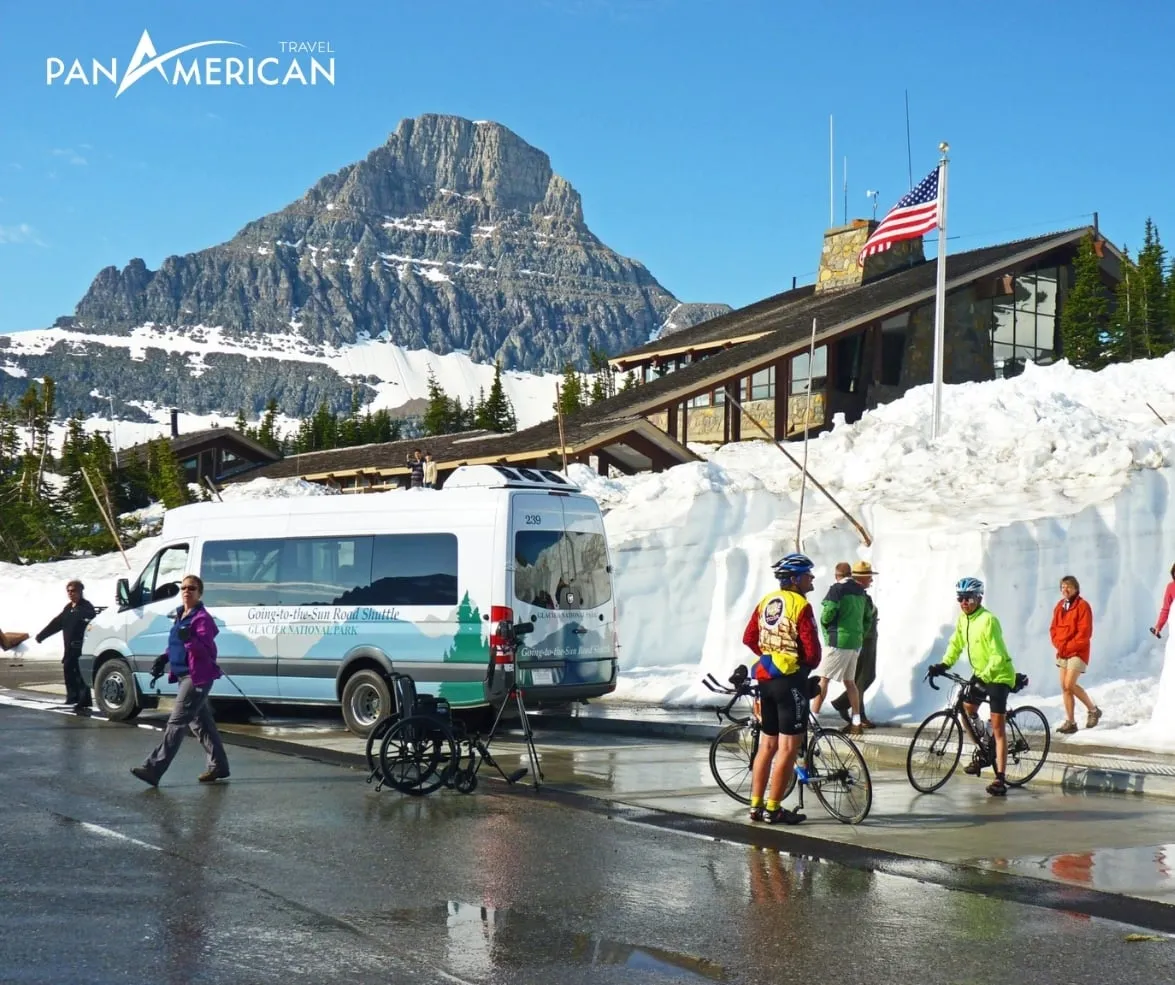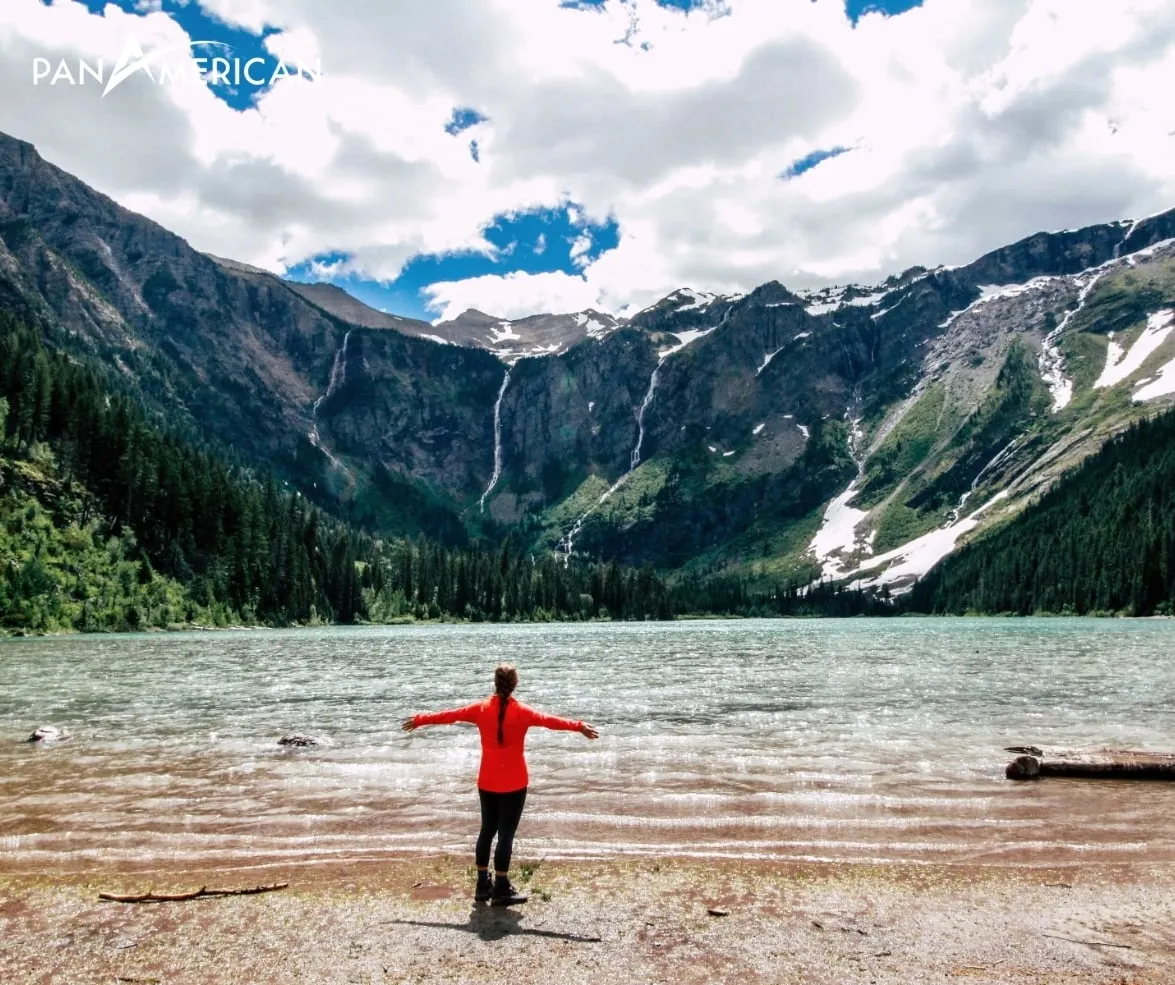Going-to-the-Sun Road, the heart of Glacier National Park, is more than just a road; it’s an awe-inspiring journey through some of North America’s most magnificent natural landscapes. With breathtaking hairpin turns hugging mountain cliffs, panoramic vistas stretching to the horizon, and the chance to get close to Glacier’s diverse ecosystem, driving the Going-to-the-Sun Road is an unforgettable experience. This article serves as your detailed guide, helping you plan and fully enjoy this stunning route.
Discovering Going-to-the-Sun Road
Going-to-the-Sun Road, a masterpiece of engineering and a tourism icon of Glacier National Park in Montana, USA, spans approximately 50 miles (80 km). It bisects the park’s heart and crosses the Continental Divide. Completed in 1932, this road is not merely a transportation route but a work of art blending into the pristine wilderness. The most remarkable feature of Going-to-the-Sun Road is its impressive elevation, peaking at Logan Pass at 6,646 feet (2,026 meters) above sea level. This vantage point offers visitors panoramic views of majestic mountains, turquoise glacial valleys, and rich flora and fauna.
The road is seasonally open, typically from late June or early July to mid-October, depending on weather conditions and snowfall. Driving on Going-to-the-Sun Road is not just about getting from one point to another; it’s a unique travel experience where each bend reveals a new natural masterpiece, inviting you to stop and explore.

Planning Your Drive on Going-to-the-Sun Road
To ensure a smooth and memorable drive on Going-to-the-Sun Road, advance planning is crucial. Here are key factors to consider:
Ideal Timing: Summer (July to September) is the best time to drive Going-to-the-Sun Road. The weather is warm, with minimal rain, and the road is cleared of snow, ensuring safety and optimal visibility. However, this is also peak tourist season, with heavy traffic. Consider arriving early or later in the day to avoid congestion and secure parking.
Permits and Reservations: Since 2023, Glacier National Park requires a “Vehicle Reservation” permit for vehicles accessing Going-to-the-Sun Road during peak season (typically late May to early September). You need to book this permit online in advance at Recreation.gov. The permit is valid for one day and allows park entry within your chosen time slot. In addition to the vehicle permit, you still need to purchase a Glacier National Park entrance pass or use an America the Beautiful Pass if you have one.
Driving Time: Despite its 50-mile length, allocate at least 2-3 hours for a one-way drive on Going-to-the-Sun Road, excluding stops for sightseeing and photography. The speed limit is quite low, averaging 25-30 mph (40-45 km/h), and many sections are narrow and winding, requiring slow and careful driving.
Vehicle Preparation: Ensure your vehicle is in good condition before embarking on the journey. Check brakes, tires, oil, coolant, and other critical systems. Fill up your gas tank before entering the park, as there are no gas stations inside. If renting a car, choose a vehicle suitable for mountainous terrain and winding roads.
Essentials to Pack: Bring plenty of water, snacks, sunscreen, a hat, sunglasses, a light jacket, and comfortable shoes for walking. Don’t forget your camera or phone to capture the stunning moments along the way.
Safe Driving Tips for Going-to-the-Sun Road
Driving on Going-to-the-Sun Road demands high concentration and caution due to the challenging terrain and heavy traffic, especially during peak season. Here are some safety tips to keep in mind:
Obey Traffic Laws: Always drive on the right side of the road, adhere to speed limits, and pay attention to traffic signs. Yield to Red Bus tours and larger vehicles, especially on narrow sections.
Maintain Vigilance: Focus on driving and carefully observe the road, particularly around blind curves. Be aware of steep cliffs, drop-offs, and other vehicles.
Keep a Safe Distance: Maintain a safe following distance from the vehicle ahead, especially when descending or stopping on slopes.
Use Engine Braking: When going downhill, use engine braking (shift to a lower gear) to reduce strain on your brakes and prevent overheating.
Find Safe Pull-outs: Going-to-the-Sun Road has numerous pull-outs along the way for scenic stops and photo opportunities. Only park in designated areas and ensure your vehicle does not obstruct traffic. Avoid sudden stops on the road or in blind spots.
Watch for Wildlife: Glacier National Park is home to various wildlife, including bears, mountain goats, and elk. They may unexpectedly appear on or near the road. Drive slowly, observe carefully, and maintain a safe distance from animals. Do not feed wildlife and do not exit your vehicle when encountering wild animals.
Check Weather Conditions: Mountain weather can change rapidly. Before driving, check the weather forecast and road conditions. If there is heavy rain, fog, or snowfall, consider postponing your trip or driving more slowly and cautiously.

Must-See Stops Along Going-to-the-Sun Road
Going-to-the-Sun Road is not just a driving route but a journey of discovery filled with breathtaking sights. Here are some must-stop locations you shouldn’t miss:
Lake McDonald: The starting or ending point of Going-to-the-Sun Road (depending on your direction), Lake McDonald is the largest and deepest lake in Glacier National Park. Stop at Apgar Village at the southern end of the lake to enjoy lake views, rent kayaks or canoes, or stroll along the shore.
Avalanche Creek: A popular stop with a short trail leading to Avalanche Falls and the stunning Avalanche Gorge. It’s an ideal spot for an easy hike and to admire the beauty of the old-growth forest and waterfalls.
The Loop: A famous hairpin turn on the road, where you can observe the impressive engineering of the road and admire the majestic mountain scenery.
Logan Pass: The highest point on Going-to-the-Sun Road, Logan Pass is a major visitor center with a large parking area (often crowded in peak season), restrooms, and popular hiking trails like Hidden Lake Trail and Highline Trail. From Logan Pass, you can enjoy 360-degree views of the Continental Divide and surrounding glaciers.
Wild Goose Island Overlook: One of the most iconic viewpoints on Going-to-the-Sun Road, Wild Goose Island Overlook offers stunning views of St. Mary Lake and the small Wild Goose Island prominently situated in the lake. It’s a perfect spot for sunrise or sunset photography.
St. Mary Lake: Located on the east side of Going-to-the-Sun Road, St. Mary Lake is the second-largest lake in the park, surrounded by towering mountains and evergreen forests. Stop at the St. Mary Visitor Center to learn more about the park, take a boat tour on the lake, or engage in other outdoor activities.

Alternative Transportation Options
If you prefer not to drive Going-to-the-Sun Road yourself, or couldn’t secure a vehicle permit, there are other transportation options to explore this route:
Red Bus Tours: Iconic vintage red buses, restored from the 1930s, are a symbol of Glacier National Park. Red Bus Tours offer guided tours on Going-to-the-Sun Road and other areas in the park. It’s a relaxing and enjoyable way to see the sights and learn about Glacier’s history and nature.
Free Shuttle System: Glacier National Park provides a free shuttle bus service operating along Going-to-the-Sun Road and some other areas. The shuttle is an excellent option for getting between attractions, especially if you plan to hike and want to avoid parking hassles.
Biking: For cycling enthusiasts, Going-to-the-Sun Road is an exciting challenge. However, you need to be in good physical condition and have experience cycling long distances in mountainous terrain. Consider biking in the early morning or late afternoon to avoid heat and heavy traffic.
Conclusion
Going-to-the-Sun Road is truly a gem of Glacier National Park and one of the most beautiful driving routes in the world. With careful preparation and a spirit of adventure, you’ll have a safe, exciting, and unforgettable driving experience. Whether you’re an experienced driver or a beginner, Going-to-the-Sun Road is ready to welcome and captivate you with its pristine and majestic natural beauty. Start planning your trip today and discover the wonders of Glacier National Park!